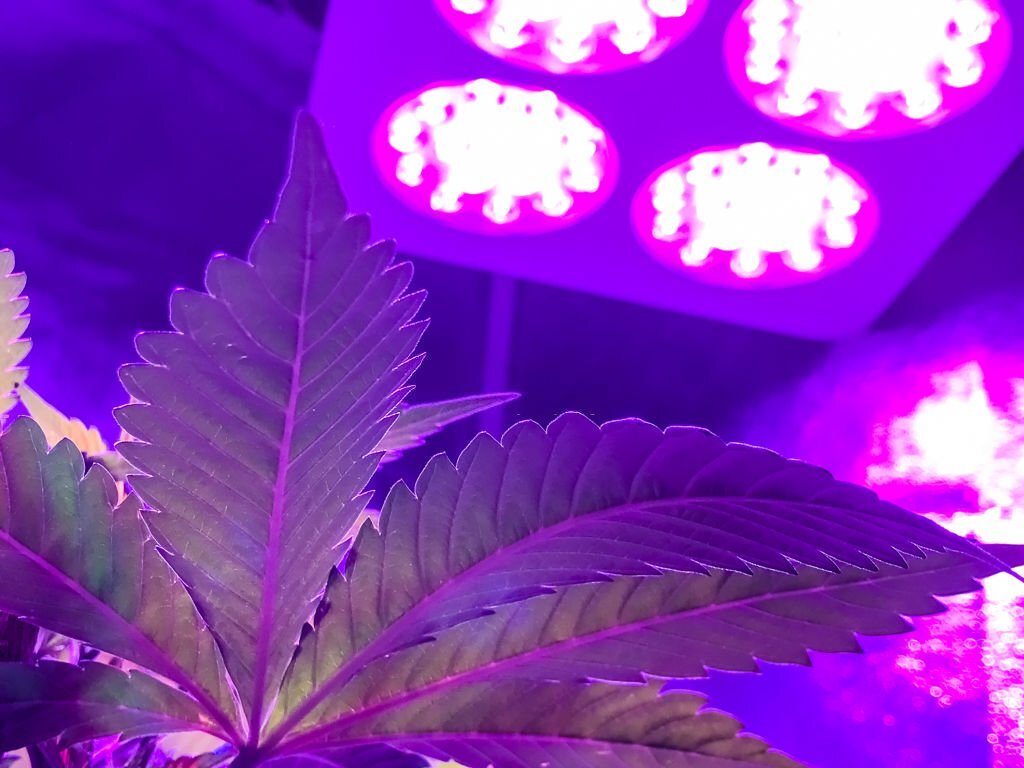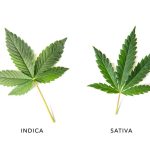🔥 Website for Sale - Contact Us
LED vs. HPS Cannabis lighting system which is the best for a cannabis grow tent setup? The two main contenders in the world of cannabis grow lights are LED (Light Emitting Diode) and HPS (High-Pressure Sodium) systems. Both have their own set of advantages and disadvantages, but how do you know which one is right for you?
This comprehensive guide we explore the world of LED and HPS lighting systems, compare their performance and look at setting up your grow tent for optimal results. By the end of this guide, you’ll have a clear understanding of the differences between LED and HPS lights.
I. LED Lighting Systems
A. The Functioning of LED Lights
LED, or Light Emitting Diode, technology has transformed the way we illuminate our homes, offices, and, of course, grow tents. But what exactly are the inner workings of these efficient and versatile lights? Let’s examine the mechanics of these innovative lights.
Essentially, LEDs are semiconductor devices that directly convert electrical energy into light. When an electric current passes through the semiconductor material, it recombines with electron holes (spaces where electrons would typically reside), releasing energy in the form of photons, or light particles. This process, known as electroluminescence, is what generates the visible light we see from an LED.
A key advantage of LED technology is its capacity to produce specific wavelengths of light. The color of the emitted light depends on the semiconductor material used in the diode. By using different materials and adjusting their composition, manufacturers can create LEDs with a wide range of colors, including those that replicate the full spectrum of sunlight.
This precise control over light wavelengths makes LEDs particularly appealing for cannabis growers. By modifying the spectrum, growers can supply their plants with the ideal light conditions for each growth stage, from vegetative to flowering. As we’ll explore further in this guide, this full-spectrum capability, combined with other benefits such as energy efficiency and reduced heat output, makes LED grow lights an attractive option for many cultivators.
B. Advantages of LED Lights for Cannabis Growth
LED lights have become popular among cannabis growers, and with good reason. They offer numerous benefits over traditional lighting systems, making them a top choice for many cultivators. Let’s examine the advantages of LED lights for cannabis growth more closely.
Energy efficiency: A primary selling point of LED grow lights is their energy efficiency. LEDs consume significantly less energy than other lighting systems, such as HPS.
Reduced heat output: LED lights generate far less heat compared to HPS counterparts. Excessive heat can harm cannabis plants, leading to issues like heat stress, decreased yields, and even plant death.
Full spectrum lighting: As previously mentioned, LED lights can be designed to emit specific wavelengths of light. This allows manufacturers to create full-spectrum LED grow lights, which closely resemble the natural sunlight that cannabis plants thrive in. Full-spectrum lighting ensures that your plants receive the appropriate type of light at each growth stage, from vegetative to flowering, resulting in healthier plants and potentially higher yields.
Longevity: LED lights have a considerably longer lifespan compared to other lighting options, such as HPS bulbs. While HPS bulbs need to be replaced every 10,000 to 20,000 hours, high-quality LED lights can last anywhere from 50,000 to 100,000 hours before losing their efficiency. This means less frequent light replacement and lower long-term costs for your grow operation.
These benefits make LED lights a formidable contender in the realm of cannabis grow lights. However, it’s crucial to weigh these advantages against any potential drawbacks, such as initial cost and quality variance among manufacturers, before deciding if LED lights are the best choice for your grow tent setup.
C. Possible Drawbacks of LED Lights
While LED grow lights offer numerous benefits for cannabis cultivation, it’s vital to be aware of their potential drawbacks before committing to a lighting system. Let’s explore some of the challenges associated with LED lights.
Initial cost: One of the most significant barriers to entry for LED grow lights is their relatively high initial cost. Compared to HPS lights, LEDs can be more expensive upfront.
Quality variance among manufacturers: Not all LED grow lights are created equal. Some LED lights may not deliver the same level of performance as others, making it essential for growers to research and select reputable brands. Look for reviews, recommendations from experienced growers, and industry certifications to ensure you’re investing in a high-quality LED grow light.
While LED lights offer energy efficiency, lower heat output, and full-spectrum lighting, the initial cost and potential quality variance can be significant factors to consider.
II. Exploring the World of HPS Lighting Systems
A. The Fundamentals of HPS Lights
High-Pressure Sodium (HPS) lights have long been favored by cannabis growers, largely due to their impressive light intensity and proven results. But what makes these powerful lights tick? Let’s delve into the mechanics of HPS lighting systems.
HPS lights fall under the wider umbrella of High-Intensity Discharge (HID) lights. They work by sending an electric current through a gas-filled tube, which then emits light. The gas contained within the HPS light tube is primarily sodium, with additional elements like mercury and xenon. When the electric current flows through the gas, it creates a plasma arc that generates a bright, intense light.
HPS lights produce a color spectrum leaning heavily towards the red and orange end, making them ideal for the flowering stage of cannabis growth. However, this means they may not offer the perfect light conditions for the vegetative stage, which generally requires more blue light. To achieve a more balanced spectrum throughout the entire growth cycle, some growers opt to combine HPS lights with other types of lighting, such as Metal Halide (MH) or LED lights.
B. The Perks of HPS Lights for Cannabis Growth
High-Pressure Sodium (HPS) lights have long been a mainstay in the cannabis growing community. Their high light intensity and history of successful harvests make them a popular choice among many cultivators.
Track record of success: Cannabis growers have been relying on HPS lights for decades, and these lights have consistently delivered strong results. This wealth of knowledge and experience with HPS lights offers invaluable insights and guidance for newcomers, helping them achieve successful harvests with greater ease.
Intense light output: HPS lights boast the ability to produce a high intensity of light, which is crucial for cannabis plants during the flowering stage. The bright, powerful light from HPS systems can foster substantial bud development and boost yields, especially when paired with proper cultivation techniques.
Affordable upfront cost: In comparison to LED lights, HPS systems usually have a lower initial cost, making them more accessible to beginners or growers on a tight budget.
C. The Challenges of HPS Lights
Energy consumption: HPS lights aren’t as energy-efficient as LED lights, meaning they require more electricity to produce the same amount of light. This can result in higher energy bills and a larger carbon footprint for your grow operation.
Heat output: HPS lights produce a substantial amount of heat, which can be difficult to manage within a grow tent. To counteract the heat generated by HPS lights, you may need to invest in extra cooling systems, such as fans or air conditioners, which can increase your overall costs and energy consumption.
Bulb replacement: HPS bulbs have a shorter lifespan compared to LED lights, usually lasting between 10,000 and 20,000 hours before needing replacement. The process of replacing bulbs not only adds to the overall cost of using HPS lights but can also be time-consuming and disruptive to your grow operation.
While HPS lights boast a proven track record and deliver high light intensity, their energy consumption, heat output, and bulb replacement requirements are important factors to keep in mind.
III. Comparing LED and HPS Lights for Cannabis Growth
A. Yield per watt: A crucial consideration for any grower is the yield per watt, which measures how much usable light a plant receives per watt of electricity consumed. While HPS lights have traditionally been known for their high yield per watt, advances in LED technology have significantly narrowed the gap. Today, high-quality LED grow lights can deliver yields per watt comparable to, or even exceeding, those of HPS lights, making them a more energy-efficient option.
B. Spectrum quality: The quality of the light spectrum plays a significant role in cannabis growth. While HPS lights excel at providing red and orange light, which is ideal for the flowering stage, they may not be as well-suited for the vegetative stage, which requires more blue light.
C. Cost-effectiveness: When considering the cost of your lighting system, it’s important to factor in both initial costs and ongoing expenses. While HPS lights typically have a lower upfront cost, their higher energy consumption and more frequent bulb replacements can lead to higher long-term expenses. LED lights may have a higher initial cost, but their energy efficiency and longevity can result in long-term savings.
D. Overall efficiency: In terms of overall efficiency, LED lights have the edge over HPS lights. Their lower heat output means less energy is wasted as heat, and it’s easier to maintain optimal temperature and humidity levels in your grow tent. Additionally, the full-spectrum lighting capabilities of LED lights can help ensure your cannabis plants receive the ideal light conditions throughout their entire growth cycle.
E. Environmental impact: For environmentally conscious growers, LED lights are the clear winner. Their energy efficiency and long lifespan result in lower energy consumption and reduced waste, minimizing the environmental impact of your grow operation.
IV. Optimizing LED and HPS Lights in Your Grow Tent: Best Practices
Having delved into the differences between LED and HPS lights, it’s time to examine best practices for utilizing them in your grow tent. Regardless of the lighting system you select, adhering to these guidelines will help you optimize your cannabis plants’ growth potential and achieve bountiful harvests.
A. Positioning your lights: Properly positioning your grow lights is essential for ensuring even light distribution and avoiding hotspots. Typically, HPS lights need to be hung higher above the canopy due to their intense heat output. In contrast, LED lights can be placed closer to the plants since they generate less heat. Always consult the manufacturer’s recommendations for optimal hanging height and adjust as needed throughout the growth cycle.
B. Light cycles: Cannabis plants require specific light cycles during different growth stages. In the vegetative stage cannabis typically need 18 hours of light and 6 hours of darkness, while the flowering stage requires 12 hours of light and 12 hours of darkness. Adjust your light schedule accordingly to support your plants’ growth and development.
C. Combining lighting systems: Some growers opt to combine LED and HPS lights to leverage the strengths of each system. For instance, you can use LED lights during the vegetative stage for their energy efficiency and full-spectrum capabilities, then switch to HPS lights during the flowering stage to enhance yields with their high light intensity. Alternatively, you can use both types of lights simultaneously to create a more balanced spectrum throughout the entire growth cycle.
D. Monitoring temperature and humidity: No matter your lighting choice, it’s crucial to maintain optimal temperature and humidity levels in your grow tent. Closely monitor these factors and adjust your ventilation, heating, or cooling systems.
E. Regular maintenance: For HPS lights, be prepared to replace bulbs more frequently than with LED lights, as they have a shorter lifespan.
Whether you opt for LED or HPS lights, the key is to carefully manage various factors influencing plant growth, such as light intensity, spectrum, temperature, and humidity, to achieve the best possible outcomes.
V. Selecting the Ideal Lighting System for Your Cannabis Grow Tent
A. Budget: Your budget will undeniably influence your decision. If you’re working with a limited budget, HPS lights may be more attractive due to their lower initial cost. However, remember the long-term savings offered by LED lights regarding energy efficiency and reduced maintenance expenses.
B. Grow space size: For smaller grow tents, LED lights might be more appropriate because of their lower heat output, simplifying temperature and humidity management. Conversely, for larger grow spaces, HPS lights can provide higher light intensity, potentially enhancing yields.
C. Experience level: If you’re a novice in cannabis cultivation, HPS lights may be more appealing due to their proven track record and the wealth of knowledge available to guide you. However, as you gain experience and familiarity with different lighting systems, you might discover that LED lights offer greater flexibility and control over your grow environment.
D. Environmental impact: If sustainability and environmental impact are priorities for you, LED lights emerge as the obvious choice. Their energy efficiency and long lifespan can help minimize your grow operation’s carbon footprint and overall environmental impact.
E. Personal preferences: In the end, your personal preferences and priorities will significantly influence your decision. While some growers advocate for HPS lights, others have attained excellent results with LED lights.
To conclude, choosing between LED and HPS lighting systems for your cannabis grow tent depends on various factors, including budget, grow space size, experience level, environmental impact, and personal preferences.
3 Popular LED Lightning on the market today
Here are three popular LED grow light products and some resources to help you make an informed decision:
- Spider Farmer SF-2000 LED Grow Light:
Official website
Amazon link
- Mars Hydro TSW 2000W LED Grow Light:
Official website
Amazon link
- Viparspectra Pro Series P2000 LED Grow Light:
Official website
Amazon link
Check out the following resources for more information on cannabis cultivation and lighting systems:
- Grow Weed Easy: A comprehensive resource for cannabis cultivation, including lighting systems, grow techniques, and troubleshooting tips.
Official Website
- LED Gardener: A blog and forum dedicated to LED grow lights, offering product reviews, comparisons, and DIY guides.
Official Website
- Rollitup: An online forum where cannabis growers can discuss various topics, including lighting systems, grow techniques, and plant care.
Official Website
3 Popular HPS Lightning on the market today
Here are three popular HPS grow light products and some resources to help you make an informed decision:
- iPower 1000W HPS MH Digital Dimmable Grow Light System:
Official website
Amazon link
- VIVOSUN Hydroponic 600W HPS MH Grow Light Kit:
Official website
Amazon link
- Sun System HPS 150W Grow Light Fixture:
Official website
Amazon link





